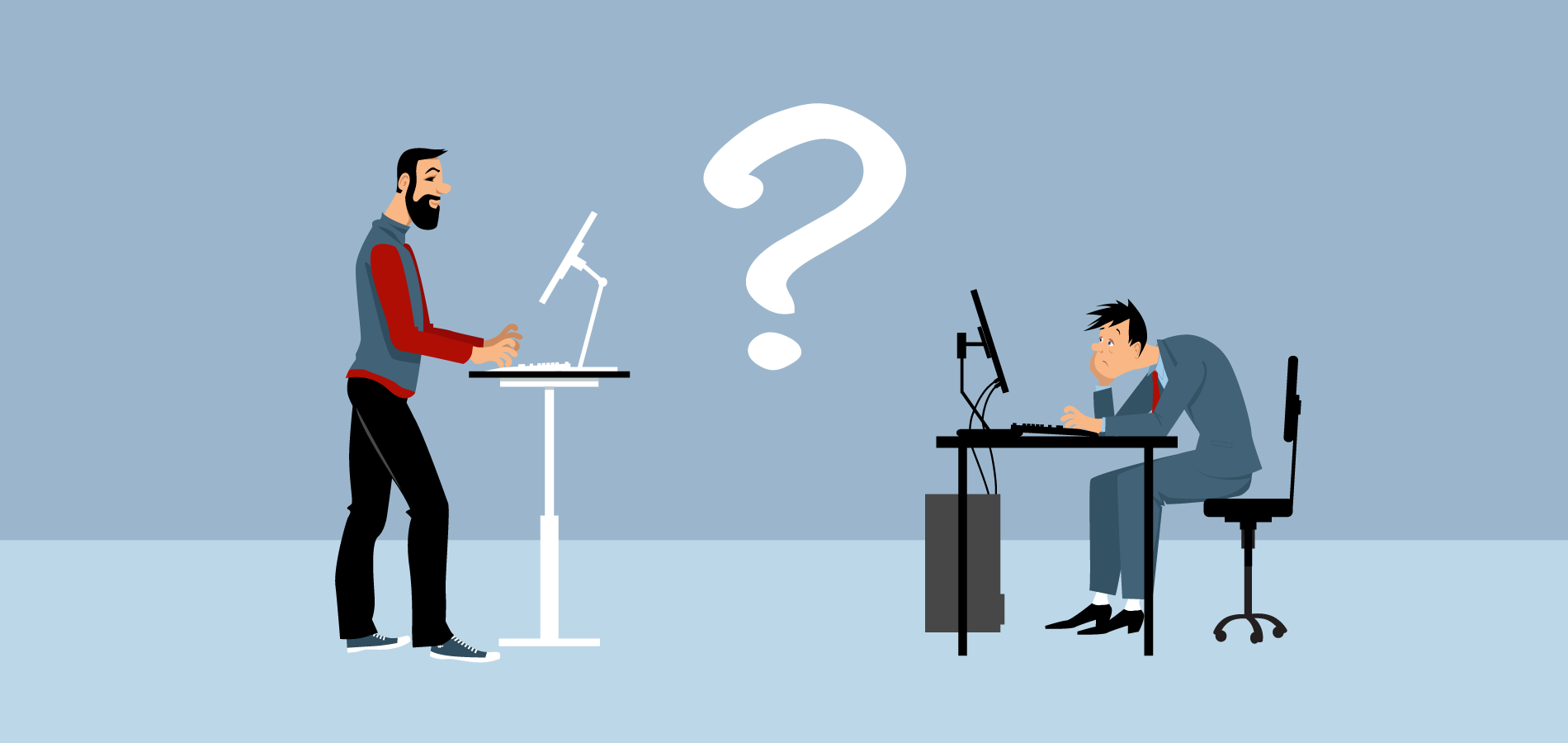In case you haven’t noticed, standing desks are a booming trend in today’s workplace. The global standing desk market is estimated to reach $2.8 billion by 2025 (Credence Research, 2017), making it a trend that appears to be here to stay. All the rage around standing desks seems to stem from the same inherent issue in the modern workplace… “sitting is the new smoking,” so therefore, logic would suggest that standing desks should be the solution.
Today, we'll dive into the truth about standing desks.
To know if they are the solution, let’s ask, “What specific problem are standing desks intended to solve?” I would pose that the hype around standings desks is that standing desks are intended to solve or prevent issues that stem from sedentary behavior in the workplace. Issues like back pain, neck pain, sluggishness, and lost productivity. Standing desk popularity is also focused towards positive outcomes like performance, workplace culture, and employee health. Therefore, if we would expect standing desks to prevent issues and create a positive outcome, than those would be the metrics of their inherent success.
Are standing desks really worth the investment?
At inHabit, we consistently see a varying degree of outcomes when encountering businesses with existing standing desks. While some existing users are excited by their desks and allege that they have less pain and more energy, we see an equal number of gaps in the standing desk ‘equation’. Employers often are missing out on a return for their investment. While purchased with great intentions, standing desks won’t be effective if they go under-utilized, over-utilized or are not used ergonomically. For example, imagine walking into an office where everyone has standing desks yet you wouldn’t know it because everyone is busy sitting; would that be a worthy outcome for the investment?
On the flip-side, take for example that in a study of 7,000 workers where, “Occupations involving predominantly standing were associated with an approximately 2-fold risk of heart disease compared with occupations involving predominantly sitting.” (Journal of Epidemiology, 2018); it would seem then that whether standing desks go under-utilized, or users attempt to stand for most of their day, risks are associated with any prolonged position or repetitive task, risk factors that the study of ergonomics has long since aimed to prevent in workplaces. Standing desks are but another tool with their own set of risk factors and ergonomic precautions. Or in other words, the tool is only as good as the user.
So let’s face it, simply putting in standing desks does not guarantee that your employees will suddenly become productive, healthy, and active; this does not mean, however, that wellness initiatives involving standing desks are all for not.
If you are considering standing desks, or have already invested in them for yourself and/or your business, here are some precautions and strategies to consider in setting realistic expectations while getting the best return on your investment and user experience.
Standing all day is not the solution…
Just ask the next cashier or retail person you encounter. Standing alone is shown to only increase caloric burn by 8 calories per hour (Journal of Physical Activity and Health) and if you’ve ever tried to stand for long hours, you probably have experienced fatigue in your joints such as your feet, knees, hips, and/or back.
We encourage all users of standing desks to ease into standing for longer periods by starting with 30 min at a time then slowly increasing as long as they are comfortable doing so with the goal of reaching less than 6 hours per day of sedentary time without sitting or standing for longer than 2 hours at any given point.
If standing isn’t the solution… what is?
Probably the best advantage of using a standing desk is that they give you freedom to move. Therefore, movement is the answer. Changing your stance often, taking time to move and stretch your limbs, and learning how to stand with good posture are three simple ways to ensure standing doesn’t create more problems than it solves.
There’s a big difference between sitting in a comfy chair and standing on a hard, flat surface.
Office floors are often hard and even most carpeted offices lack a soft underlay. If you’ve gone so far as to invest in quality office chairs and standing desks, a hard floor can deter users from using their fancy desk, making their office chair even more welcoming. Even regular anti-fatigue mats only provide so much relief. The main issue here is that a flat surface provides a limited number of options for stance and posture, potentially leading to users finding their balance by locking their knees and leaning into their hips for postural support or forgoing their attempt to stand altogether.
We recommend a not-flat standing mat, designed specifically for standing desk users. This new niche product provides a terrain under-foot, giving the user more freedom to move around, stretch lower extremities, and even serves as a great foot-massage tool. For an unbiased review on the best standing mat for you, check out WireCutter’s take on standing desk mats.
Standing desks require more ergonomic awareness than regular desks.
Giving an employee the freedom to choose the height of their desk is great in the sense that the desk can be adjusted according to the users body type. While that is true, the opposite is also true. Left unchecked, giving an employee freedom to choose their desk height can also mean a greater risk of users developing repetitive strain. When considering the safety and effectiveness of standing desks consider educating users on the following:
- Proper ergonomic heights for their desk and body type for sitting and standing.
- How to adjust their devices such as monitors, keyboards, mice, and laptops.
- How to sit and stand with great posture.
- How to change their posture and stance regularly so as to keep limber while developing towards mobility rather than becoming stiff and sore.
Standing desks may not be compatible with all office types.
Open offices, cramped work spaces, and a variety of office furniture are just some common hurdles that do not make for a “one-size-fits-all” approach to standing desks. The variety of standing desks, sit-stand desks, height adjustable desks, etc. also add to reason that compatibility is key when it comes to altering or adding to the existing work space.
Problem: In open offices, privacy and noise are compromised. Add-in standing while your neighboring colleague sits, and these issues become exacerbated.
Solution: Depending on the type of desk, privacy panels can be added to travel up and down with the desk surface.
Problem: Add-on sit-stand risers can be bulky, significantly decreasing the usable space of a workstation. Ensuring that the user has enough work space to suit their job is key. Some users use very little paperwork while others need to spread out.
Solution: Add-on units, therefore, are great for minimal paper-workloads while a full-sized desk is more appropriate for users wishing to maintain the same feel and real estate of a regular desktop.
Problem: Companies that have invested in regular office desks, either through purchase or leasing, are often hesitant to add the weight of a sit-stand riser while also may not wish to ‘do-away’ with their perfectly fine furniture.
Solution: Both budget and decor are important to culture and the bottom-line, therefore we recommend that if you are invested in your current workstations and wish to keep the same look and feel of your office, consider adding just the electric height adjustable frame under existing table tops. In effect, you can save on purchasing a new table top, pay less for moving and installation, and maintain the same usability of the existing work surface.
Standing desks combat sedentary behavior; what about other common workplace symptoms like eye-strain, slumps in the afternoon, and overall work-stress?
It’s worth reiterating that standing desks are simply a tool. The expectation put on them is only as good as the strategy behind why you might invest in the first place; to support your employees in becoming more productive, healthy, and active. When it comes to achieving these goals, consider a well rounded approach to employee wellness. In identify and prioritizing relevant issues for your team consider the following:
- Look into how employee habits effect their health and stress. Encourage habits that help mitigate specific impacts on health and performance.
- Survey for the level of sedentary behavior your team already has and identify if there is a risk factor or not, from here you can decipher if standing desks or encouraging more active work habits are the more viable investment.
- Determine what other issues are that standing desks may not solve such as: aches, pains and strains, sluggishness, headaches, irritability, and work/life balance.
- Seek out resources such as training and other ergonomic tools. Consider providing your team with the option to choose what support they need so as to match a solution to a problem while ensuring the return on both the investment and the employee experience.
Ensuring your success in workplace wellness also does not have to be done alone, at inHabit Workplace Wellness we help workers and their employers to have healthier workdays through free resources, ergonomic assessments, training, and tools. Altogether, we pride ourselves on seeking out tested, proven, and relevant solutions that can meet the unique needs of businesses of all types. We help our clients to overcome common workplace stressors while working in an environment that promotes well-being. Our process focuses on ergonomic wellness, team wellness training, and healthy workspace design.
To learn more workplace wellness tips, download this inHabit Wellness brochure:

Related Reading:
Stop Running From the Bear [Stress Management in the Workplace]
Take these small steps to improve your posture in the office
The Best HSA Eligible Expenses for Stress Management
Written for: Olympia Benefits






